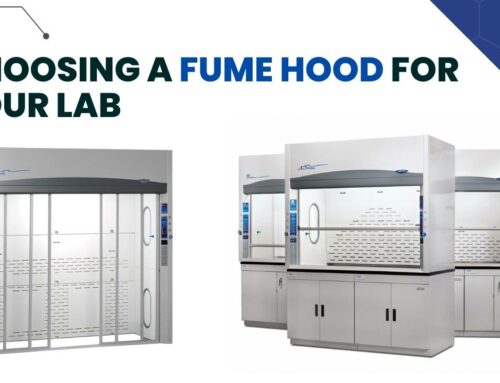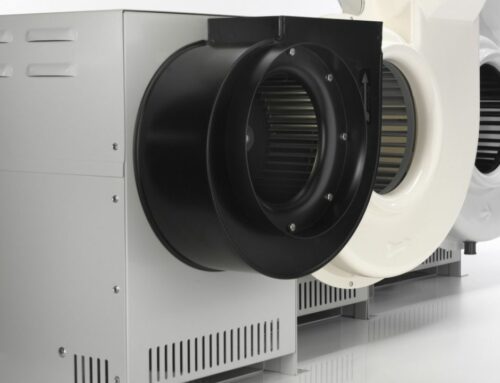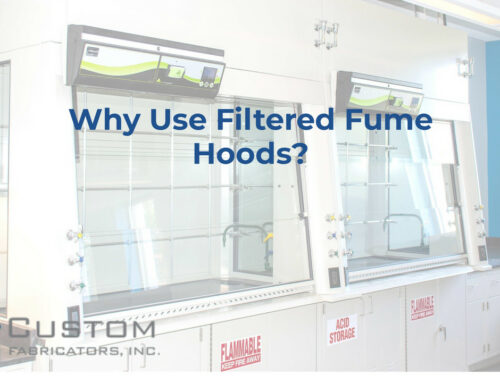Biosafety Cabinet vs Fume Hood: Exploring Their Differences
Ventilated enclosures are a must-have in any laboratory. A common question is whether you need biosafety cabinets or fume hoods. The primary purpose of ventilated enclosures is to protect users, the environment, and product/specimen from laboratory hazards.

Biosafety cabinets provide a clean work environment without the need for exhaust ductwork installation and ventilation. They also protect users who create aerosols while working with biological hazards and the product/samples.
On the other hand, fume hoods remove chemical fumes and aerosols from the work area, and commonly vent to the atmosphere. Standard laboratory fume hoods require plumbing and mechanical HVAC hookups to complete installation
Ductless hoods are similar to biosafety cabinets, since they use HEPA filtration and recirculate air back into the lab.
While both offer protection, they differ in purpose, functionality and operation.
Your requirements, budget, laboratory size, and safety considerations matter when choosing which to purchase. The best choice caters to your lab’s needs while keeping employee safety a top priority.
Table of Contents
What Are Biosafety Cabinets?
A biosafety cabinet (BSC) is a ventilated enclosure that protects the user, environment, and product. It traps biohazardous, pathogens and infectious agents in a filtration exhaust system using high-efficiency particulate air (HEPA) filters. The cabinet discharges microbe-free exhaust air back into the lab.
BSCs provide adequate containment for safe manipulation of moderate and high risk infectious agents, including viruses. Keeping them well maintained and using in conjunction with good microbiological handling techniques produces the best results. BSCs require certification when installed, moved and annually [OSHA 29 CFR 1910.1030(e)(2)(iii)(B)].
Research laboratories use BSCs for various applications. These include handling pathogen microorganisms, human or animal tissue, genetically modified microorganisms, human gene studies and recombinant DNA.
Classes and Types of Biosafety Cabinets
There are three classifications of BSCs, based on their containment capabilities when working with biological agents.

Class I BSCs
Class I BSCs are designed solely for user protection. They have an inflow that protects the user, but outside air can contact the product in the work area. Therefore, Class I BSCs offers no product protection. They are appropriate for agents requiring Biosafety Level (BSL-) 1, 2, or 3 containment.

Class II BSCs
They protect the user, environment, and product from contamination. They have inflow that protects the user and a clean HEPA-filtered downflow to protect the work area and the product. They are four types of Class II BSCs, i.e., A1, A2, B1, and B2. The main difference between the various types is the minimum inflow velocities and exhaust systems.

Class III BSCs
Also known as glove boxes, they provide maximum protection. Class III biosafety cabinets have a completely closed front. Work is done through integrated gloves.
The cabinet is gas-tight. All materials enter and leave through a double-door autoclave or dunk tank.
The cabinet protects the product or specimen by a stream of HEPA filtered air. The work area is under negative pressure, so contaminants are continuously removed from the work zone and filtered by an exhaust HEPA filter. The air then passes through a second filter or incinerator before being recirculated back into the lab.
Class III cabinets are crucial for working with any BSL-4 agents. These may include aerosols of pathogens or toxins.
Choosing the appropriate BSCs depends on user and product/process protection needed.
What Are Fume Hoods?
Fume hoods are a type of laboratory enclosures, primarily used for protection against gases, chemical splatter, carcinogens and other volatile compounds. Hoods generally use a duct system that exhausts the contaminated air within the hood into the atmosphere.
Fume hoods also protect from chemical spills and fires by acting as a physical barrier. They are the primary control device for protecting workers who work with flammable or toxic chemicals. This is achieved by continuously delivering airflow away from the user to the work area.
Fume hoods handle toxic gasses, chemical spills, odorous material, reactive material, carcinogens, flammables, aerosols, or other poisonous and volatile material. Bench top fume hoods generally are quoted with base cabinets beneath and acid/solvent/vented or flammable cabinets are always smart options. This is a great area to store harmful lab materials while keeping your technicians safe. They are useful in research laboratories, educational facilities and forensic labs.
Hoods usually need to be selected according to their specific use. A radioisotope hood for example, is lined with stainless steel.
Types of Fume Hoods
There are two main types of fume hoods, ducted and ductless fume hoods.
Ducted
Ducted hoods handle a variety of chemicals. Fumes or vapors are safely drawn out of the lab to the building’s exterior using fans and a ductwork system.
The ducted fume hoods are generally placed in a fixed position in the lab.
Ductless
Ductless fume hoods operate in a similar manner to biosafety cabinets. Contaminated air moves through HEPA or Ultra-Low Particulate Air (ULPA) filters. The purified air is then recirculated back into the lab.
Ductless fume hoods may be a good choice for lab applications that fall within the filters’ capabilities. This type of hood offers cost savings and improved layout flexibility.
Difference Between Biosafety Cabinets vs. Fume Hoods
| Biosafety Cabinets | Fume Hoods | |
|---|---|---|
| Applications | Infectious microorganisms and other hazardous particulates | Dangerous chemicals, toxic gases, odorous and reactive material, chemical spills, aerosols, carcinogens, flammables, or other poisonous and volatile materials |
| Configuration | Vertical | Vertical or horizontal, or both |
| Filters/Exhaust | HEPA/ULPA filters or vented to atmosphere | HEPA/ULPA filters or vented to atmosphere |
| Uses | Cell culture processing or applications where the user, product, and environmental protection is needed. This works together with the mitigation of cross-contamination on the work surface. | Research laboratories, educational facilities, and forensic laboratories |
Considerations
Safety Considerations: BSCs work best with infectious microorganisms and other hazardous particulates. Fume hoods work best for toxic fumes or vapors. Consider the application, together with the type of protection you need when choosing for your laboratory.
Requirements: Conduct a needs assessment, then match the requirements to an enclosure that will provide the function and safety personnel needs. Fume hoods and biosafety cabinets serve different applications.
Costs: It is crucial to take into consideration the lifetime cost of a particular class or model. Units must be maintained to operate at peak efficiency. Ductless systems need filter changes to provide safe air filtration.
Lab size: Space is precious. Therefore, it is essential to keep this in mind when looking for a cabinet or fume hood.
Common Questions
Are Ductless Fume Hoods the Same as Biosafety Cabinets?
BSCs may be referred to as ductless fume hoods. However, fume hoods are meant specifically to protect against chemicals and vapors from entering into the lab environment. Ductless fume hoods are not officially BSCs, but they can offer protection from particulates when fitted with HEPA/ULPA filters.
What Are Laminar Flow Hoods?
Laminar flow hoods protect products and specimens from contamination by directing air through HEPA filters within an enclosed and sterile workspace. Unlike fume hoods and biosafety cabinets that protect the user, laminar flow hoods only help preserve the product.
Summary
The first step towards selecting the proper laboratory enclosure is knowing the type of protection you need. BSCs provide user, environment and product/process protection. Fume hoods offer different kinds of protection personal and environmental protection.
A needs assessment should always be the starting point. In-depth research on all the available biosafety cabinet and fume hoods options should then follow.
Custom Fabricators offers biosafety cabinets and fume hood solutions for your lab. Our team works with you to identify the proper solution for your needs. We can also help you price out various solutions to best fit your budget.
Contact us with any questions or for a quote.






